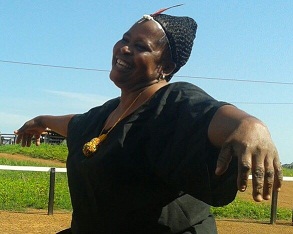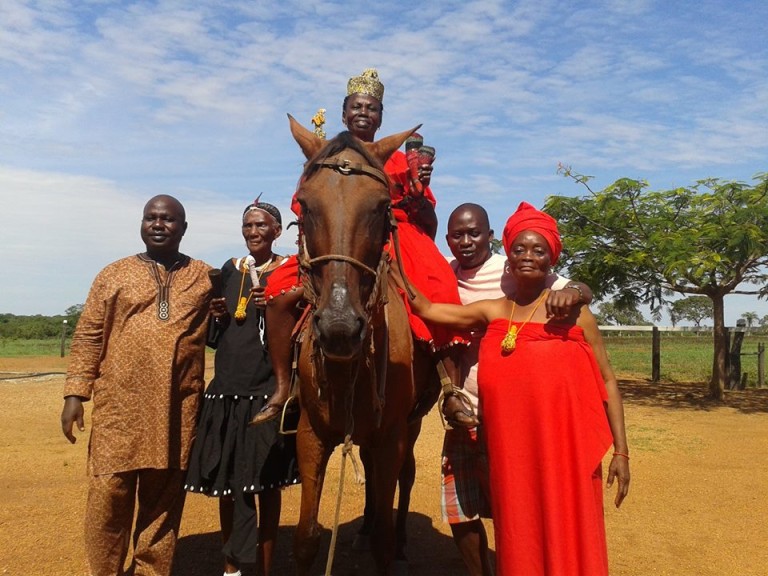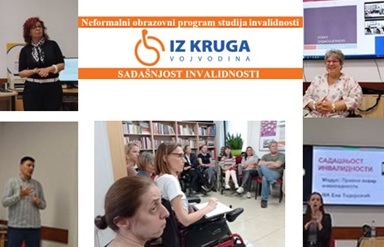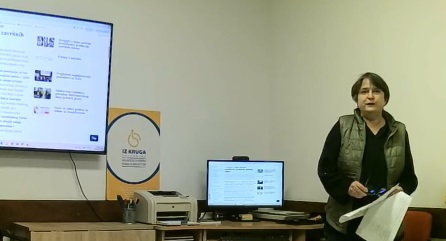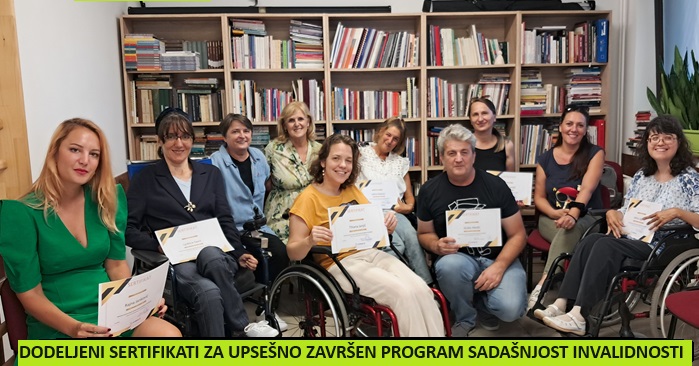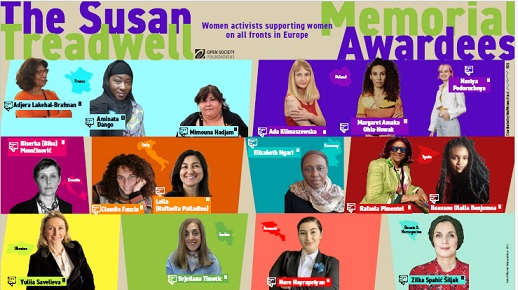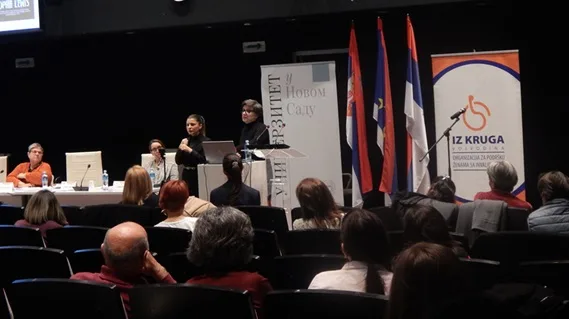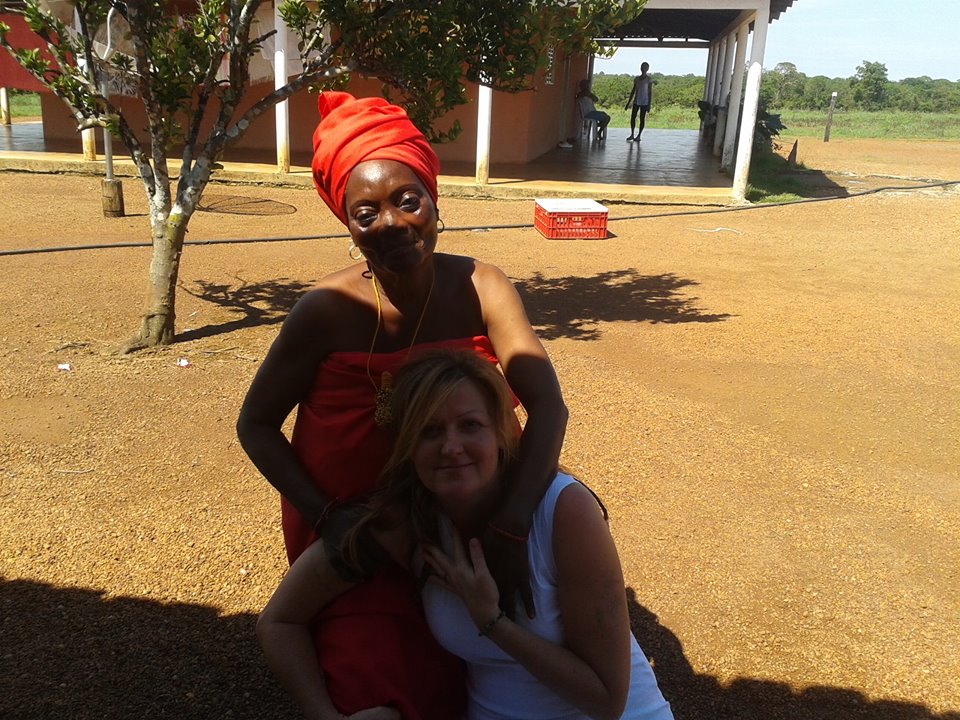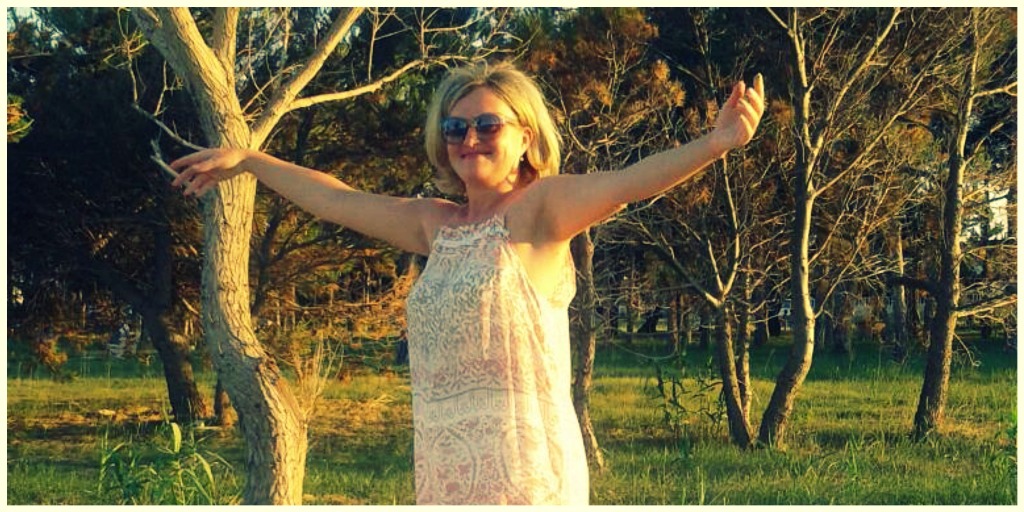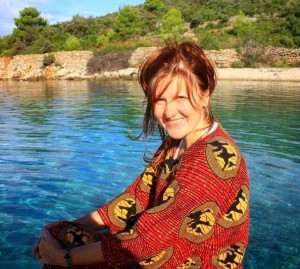 According to her official education, Mateja Tomšič Akengen is an economist, born in Slovenia, where she spent the first three decades of her life in a pretty normal way, integrated into the modern world and its requirements. And then … At the meeting point of apparently irreconcilable opposites – economy and healing, psychology and spirituality, urban and natural, real and abstract – a path opened up, leading her to the innate vocation. Because being a shaman is to simultaneously reside in two worlds, being terrestrial and spiritual, to have access, in the cooperation of the contrasts, to the complete picture of yourself, of life and the world.
According to her official education, Mateja Tomšič Akengen is an economist, born in Slovenia, where she spent the first three decades of her life in a pretty normal way, integrated into the modern world and its requirements. And then … At the meeting point of apparently irreconcilable opposites – economy and healing, psychology and spirituality, urban and natural, real and abstract – a path opened up, leading her to the innate vocation. Because being a shaman is to simultaneously reside in two worlds, being terrestrial and spiritual, to have access, in the cooperation of the contrasts, to the complete picture of yourself, of life and the world.
The term shamanism today sounds abstract and exotic, primitive and/or tempting. It is certain that shamanism is one of the oldest spiritual traditions of the world and oldest surviving system of healing. In its simplest definition, it is a way of understanding life and the man at all levels. The word shamanism itself is of Siberian origin, but it is not used in Africa – among the West African Yoruba communities, people designate male shamans and female shamans by saying that they are the father of the mysteries of life (Babalawo) or the mother of the mysteries of life (Iyanifa). Regardless of names, the ways of researching life are similar wherever there are oases of knowledge deriving from the time when man had the awareness that all was received from nature: food, air, water… everything.
What Mateja has extensively been studying in the course of the last fifteen years is Ifa philosophy. Far from modern civilization, Ifa philosophy was kept and developed in West Africa: Nigeria, Congo, Benin, among the respective Yoruba communities in whose language Ifa means wisdom. – When I came into contact with the Iifa, I had the feeling that I discovered something truly authentic – tells Mateja. Between the members of the Yoruba community, Ifa is transferred according to the traditional ways: through learning, contemplation and ritual initiations. This knowledge has spread outside Africa primarily thanks to Baba King. Of Yoruba origin, Baba King studied and received his doctorate at the University of Sao Paolo, Brazil, where he later years was a lecturer at the Department of African Studies and researcher of Yoruba culture and religion. In this way, in Brazil such blend was realized, combining traditional African wisdom with the modern western world and with the knowledge from the fields of psychology, sociology, business. It was precisely in Brazil that Mateja was initiated to Ifa, and that the first non-African group was formed, to which the Ifa knowledge was available in the traditional way. It was also a chance to record for the first time part of the Ifa heritage.
– We wrote down part of that mythology – explains Mateja – through which the Ifa became available to the Western world.
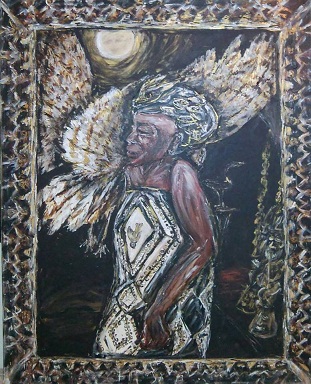 The Ifa mythology, an invaluable treasure trove of stories, is nowadays under UNESCO protection. Mythology provides us the key to the deep insights into the psychology of personality, in the understanding of the soul – because psyche is the Greek word for soul. Representing the history of the soul, mythology is never univocal. Likewise, neither shamanism nor ifa are univocal systems of some universal spiritual laws an individual should have to comply with. On the contrary. The sense of shamanism is to be a support to the individual. This is the way of getting to know yourself, your (forgotten) substance and (hidden) talents, the understanding of constructive and destructive forces within yourself and the achievement of emotional stability.
The Ifa mythology, an invaluable treasure trove of stories, is nowadays under UNESCO protection. Mythology provides us the key to the deep insights into the psychology of personality, in the understanding of the soul – because psyche is the Greek word for soul. Representing the history of the soul, mythology is never univocal. Likewise, neither shamanism nor ifa are univocal systems of some universal spiritual laws an individual should have to comply with. On the contrary. The sense of shamanism is to be a support to the individual. This is the way of getting to know yourself, your (forgotten) substance and (hidden) talents, the understanding of constructive and destructive forces within yourself and the achievement of emotional stability.
Knowing yourself is the beginning of all wisdom – we have heard this innumerable times. (And yet every morning we wake up next to the alien and watch him brushing confusingly his teeth on our mirror.) In the broadest sense, shamanism as a way to explore yourself and as a return to your own sources – is something that everyone seeks, regardless of cultural boundaries and origin. We are all looking for a way to land and calm down with our life. How to tell in that state of alleviation: here I am, I will use this time in the best possible way …? How to experience yourself? Shamanism has the answers, but opens up countless questions.
In an interview with Mateja we try to discover a shamanic view on disability, breaking down myths about the lame blacksmiths and the blind prophets, we seek links between mental instability and spiritual trance, we move towards the meaning of marginalization, we detect the invisible disabilities in all of us, we examine the cages of our own beliefs, we learn how to celebrate all that is imperfect, feminine and alive …
Every culture possesses some fabricated social constructs, together with a series of stereotypes and value systems. Western culture is dualistic, we attribute to everything a sign of value (plus or minus). When it comes to disability, according to the prevailing model this is not understood simply as a (neutral) experience, but as a call to recover.
What is the attitude towards disabilities in Nigeria, among the Yoruba community and culture? In the context of this African culture, is it possible to conceive a shamanistic view of disability?
One of my African teacher from the Yoruba tribe has something we would here call a physical flaw: she is short, small and bent. When I first saw her, I thought: – What an interesting body this woman has! But there this has no importance. She is a symbol of wisdom and respect, accepted in her community the way she is. In that traditional community, the body is not so much in the focus of attention, nor is the appearance evaluated and labeled. Once, for example, a survey was conducted on how satisfied women are worldwide with their breasts: are they too large or too small, enough strong or round … But for women coming from so-called primitive cultures, this is incomprehensible: – What kind of question is this? – They were astonished. To them that made no sense because: – My breasts have given milk to my children, which is why my children survived! Such is the view of the body. The body is a fact which is not romanticized, around which no negative concepts are developed. As there is no trauma related to the concept of the body, so there is no need of attempts to justify the body in a romantic way. The teacher I mentioned often tends to make jokes in relation to her own physical condition. Once we were purchasing clothes and she – who is extremely small – her height is at the most one meter and thirty – received clothes for a woman of average stature. She put it on and laughed out loud at the view of her own look with the new clothes. Without any embarrassment or discomfort! She was born in this body and developed a respect for what she has.
Shamanism is not a dualistic, but a holistic view of the world. It is a study of the human being, and therefore it is difficult to set up a theory that would be omnivalent. Since shamanism is a support for the individual, any general theoretical explanation would be seductive and would alienate us from the sense of shamanism. For someone it is important to understand a certain phenomenon, for another, this same phenomenon is of no importance. We receive our body from both of our parents; we receive the genetics of the body, the emotional and mental genetics as well as the spiritual one. If we could choose our parents, the place or period in which to be born, would we really choose both the entire genetics and all the parameters that we receive from our ancestors?
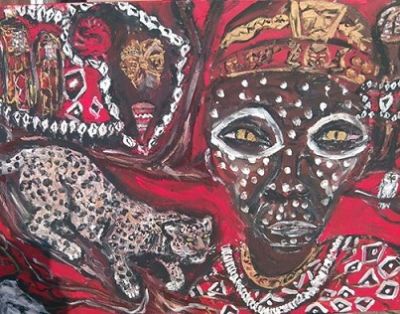 Sometimes we cannot really tell: you chose it alone. We always wonder what it is that we are missing, what do we need to balance, to support, focus on … We are looking for a way to position ourselves in our own life. We are all given a challenge: at a physical, emotional, mental and (or) spiritual level. In this sense, there is some substantial difference between people with disabilities and people that society considers not bearing any disability. In spirituality, we deal with what is invisible. When we begin to study what is invisible and abstract, we recognize that there is no difference between us, because we all have invisible disabilities. From this perception, there is no room for a critical attitude: disability has no sign. Even to the extent that a person with a disability is not considered a victim of the system, because – we are all victims of the system. Someone who is born, for example, with an inherited dependence, is a victim of genetics. And when you see all the parameters that determine an individual, you realize that there is no space for a universal theory. In fact, not only is it difficult, but it is unnecessary to affirm such a theory.
Sometimes we cannot really tell: you chose it alone. We always wonder what it is that we are missing, what do we need to balance, to support, focus on … We are looking for a way to position ourselves in our own life. We are all given a challenge: at a physical, emotional, mental and (or) spiritual level. In this sense, there is some substantial difference between people with disabilities and people that society considers not bearing any disability. In spirituality, we deal with what is invisible. When we begin to study what is invisible and abstract, we recognize that there is no difference between us, because we all have invisible disabilities. From this perception, there is no room for a critical attitude: disability has no sign. Even to the extent that a person with a disability is not considered a victim of the system, because – we are all victims of the system. Someone who is born, for example, with an inherited dependence, is a victim of genetics. And when you see all the parameters that determine an individual, you realize that there is no space for a universal theory. In fact, not only is it difficult, but it is unnecessary to affirm such a theory.
If my teacher were born here, she would be labeled, while in Nigeria she has become one of the most respected persons in the community. She was born into a culture that is not critical and in which everyone deals with her/his own stuff in her/his own way. Someone who is wise does not interfere where she/he does not belong, unless she/he is asked for advice. The level of wisdom that a person has developed is determined by the level of tolerance; tolerance is the mother of wisdom. If we want to develop the ability of acceptance and tolerance, we need to move away from the black-and-white understanding of the world and resist to this need of labeling everything. It is the tendency of reason, which must have everything under control, in order not to feel threatened. It should be recognized that there are things we cannot understand.
One of the African legends tells that Ngugi, the god of iron and metalworking, voluntarily rejected one leg and one eye. After gaining power through suffering, he returned to serve his communities as an artisan. In general, the lameness of blacksmith deities was a wandering motif present in different cultures. Most often it is interpreted as a price for discovering the secrets of fire and metal working. Do we really need to understand the story according to the dualistic model that views the sacrifice of the physical body as a way to let the soul reveal? Are, therefore, physical disfigurement and suffering a (shaman) path to gain power?
As we concluded in the previous question, shamanism is not an unified theory. In the Ifa philosophy there are 16 × 16 so-called energetic combinations and behind each one of these we find a mythical story. So, this makes a total of 256 mythical stories. Unlike what we are used to think, the myth is not directed to a group of people or to a whole community, but rather one myth corresponds to a single person. In the given context and time, a certain myth teaches a reflection and opens up different perspectives – for the individual. In Yoruba mythology, the god-blacksmith is Ogun, who is at the same time also a brave warrior without the characteristics of lameness. In one myth, physical disability manifests itself as a result of genetics, which leads him to work with the ancestors. In the second myth disability is explained with an imbalance of creative energy – that is Obatala, the one who materially creates the physical body. In the third myth, through his/her own challenge of motor disability, he person brings healing to the whole community, and the protagonist of this myth is represented with statues having sticks instead of legs. There are many approaches and mythological stories with elements of disability.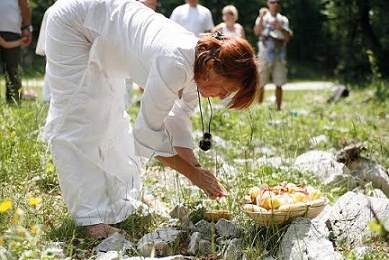
If someone has a vision impairment, he or she will most likely develop other senses and ways of orientation. There is an attempt to compensate it, so that the person can be able to move freely in the space. In this sense, disability is a development point or motivator to discover other, deeper and hidden talents. There are many talents in us that we do not even know of. We know that we use only a few percent of our mental abilities. For our basic survival, we use very little of our capacity. Through disability we develop substitutes or other talents. Someone who is visually impaired is likely to develop an inner vision, because that is a matter of survival.
The concept of sacrificing ourselves in order to evolve ourselves is also a fact of life. If we decide to have children, that is a sacrifice: we are losing part of our freedom and time for ourselves. If we choose a partnership, we also sacrifice a part of ourselves and our time, or at least we accept some compromises. If we decide to opt for complete freedom, we sacrifice part of a friendships or partnership. The very fact that we have survived so far means that so much has been sacrificed for us… at least salads, if we are vegetarians! You have to take your life in order to give life. Without romanticizing. Sacrifice is a fact in which there is nothing tragic. Each of us at some level and in some area of our existence lives with some disability – that is neither a plus nor a minus. It is simply present that element of sacrifice, and the motivation for replacing something we do not have by other means. We can become a victim of any life experience, but we can also learn and advance through that same experience.
Since blacksmithing is not a soft craft, its divinity is distinguished by strength, courage and will to survive. The Metallurgy deity Ogun gets the iron from the mud: it represents the energy charge of the inventor in us, and at the same time the need to improve and make our life easier. If someone today asks herself/himself how to improve telecommunications – that is the energy of Ogun. The study of all symbols at the level of a myth gives insights – but they represent no universal truths. Spiritual evolution can be achieved also with a softer approach, by developing love for the body. Not necessarily someone with motor disabilities wants, must, or has a desire to develop the spirit. This person can, but does not need to. The brave life warrior, the mythical blacksmith, always engages in his personal development, in discipline, in spiritual force – it requires a lot of sacrifices. If someone wants to become a top athlete – does she/he need to be disciplined? The same is true also for spiritual development. Being disciplined means to stay consistent with your path, not to interfere where it is not necessary, to tolerate what we cannot change, to calm down and apply our force to situations in which we can evolve. Somebody perceives that as a punishment and torture. Someone else just finds joy and pleasure in such work. Such is the shamanic path. But we all have moments in life when at the surface we need to evoke the warrior, the blacksmith.
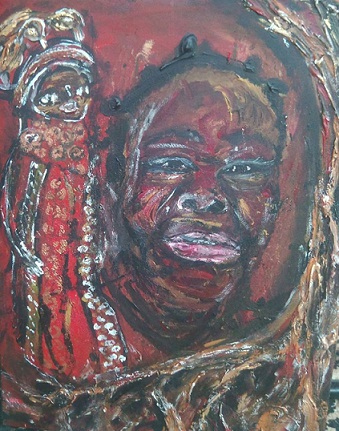 Unlike Western spirituality, in which the prevailing idea is that of martyrdom, in African philosophy the celebration of life is omnipresent. Life is not suffering and not a punishment, it brings us challenges inviting us to grow and evolve. As in a well-organized school, these challenges are appropriate for our life period and age, prompting us to adopt new knowledge and to activate additional powers. When does a lion show his strength: while he is lying or while he hunts? Certain situations are forcing us to express and enhance our own strength. You cannot eat yourself fill today until the end of life. It is the same with knowledge and skills. All of us should to repeatedly ask ourselves: what can I develop better, what are my challenges? This way we can all grow, without distinction. Today depression is considered a normal state, it is a form of disability socially accepted. In this sense, anyone who is engaged in spiritual work and personal development, deals with the invisible, with the emotional forms of disabilities. Precisely in what appears as a lack, we can, in fact, find our chance to grow. Otherwise, we would stagnate.
Unlike Western spirituality, in which the prevailing idea is that of martyrdom, in African philosophy the celebration of life is omnipresent. Life is not suffering and not a punishment, it brings us challenges inviting us to grow and evolve. As in a well-organized school, these challenges are appropriate for our life period and age, prompting us to adopt new knowledge and to activate additional powers. When does a lion show his strength: while he is lying or while he hunts? Certain situations are forcing us to express and enhance our own strength. You cannot eat yourself fill today until the end of life. It is the same with knowledge and skills. All of us should to repeatedly ask ourselves: what can I develop better, what are my challenges? This way we can all grow, without distinction. Today depression is considered a normal state, it is a form of disability socially accepted. In this sense, anyone who is engaged in spiritual work and personal development, deals with the invisible, with the emotional forms of disabilities. Precisely in what appears as a lack, we can, in fact, find our chance to grow. Otherwise, we would stagnate.
In mythological plays and traditions very often people who see through time, who have predictive power – are visually impaired. It is known that some shamans cover their eyes when traveling to another world, so that the mundane reality would not interfere. The senses are our relationship with the world, through them we experience the reality and react to it; on the other hand – our senses also limit us. How can we reach a balance?
It is certainly easier to travel in the internal memory if we exclude ourselves from all external stimuli in the space in which we live. The shaman has one leg in a parallel world, a second in this, the real world. I believe that we are by innate birth already to some extent shamans, because we have come as an essence, as the soul, from the spiritual world into this world where we received our body. Do you have emotions? Can you touch them physically? You cannot, but it does not mean they do not exist. The human being is far greater than how it looks, but many aspects of its existence are still unknowable. The only thing we know with certainty is that we know very little about ourselves. What about the rest of us? Shamanism is a deep reflection about life. How to be aware? How to be more alive? In this visible world we bring our abstract pieces, we come with certain talents and a certain missions. If we do not know our talents, if we do not remember our own mission, let alone live it – then what is the value of our life? It is as if we went to the supermarket in order to get something specific, and then bought everything else except that what we were really looking for! Do we even know we have come for? Are we in contact with ourselves?
If we focus exclusively on what comes from the outside world – we listen to someone else’s words, we adopt the established theories, we receive information – how do we penetrate inside ourselves? Do we go inside, in the area where it is stamped that record by virtue of which we exist? It exists in everyone. We carry abstract, but also visible and tangible energies: as much intuition, and as much reason. When a child is born in Yoruba culture, it is customary for parents to ask themselves: – Who is the one who is born? What is this child destined for? How can we support him? Nobody wants to be a mere biomechanism programmed to eat a bunch of salads for his life. How to be truly alive? The deep reflections on life and the awareness of one’s own talents require a deep plunge into one’s self, a contact with it. If you only see and hear what comes from the outside, can you go inside? And precisely that is our mission: to go inside the inner part of ourselves.
Someone who has a visual impairment is automatically forced to look inwards and is likely to reach certain insights faster than one who is focused on the outside world. How to reach the inner peace in the external obstacles? When I move to an inner journey and plunge into some memory, of course I will exclude the flow of external stimuli. Shamans directly do this. Children sometimes wander into conversations with imaginary friends. When parents find out, they knock this thing out of their heads reducing it to mere daydream. Later, it can happen that as adults they receive spiritual insights, but they are not prepared for the experience. Now, we explain this situation not with daydreaming, but with psychological problems. In both cases, it is possible that we are dealing with the memory of some skills these people had inside, but did not realize. It is therefore important for the shaman to be like a tree: really grounded (rooted), and at the same time open to the insights from the spiritual world.
In some communities, the state of mental instability caused by, for example, epilepsy, is interpreted as shamanic power. How do you explain this?
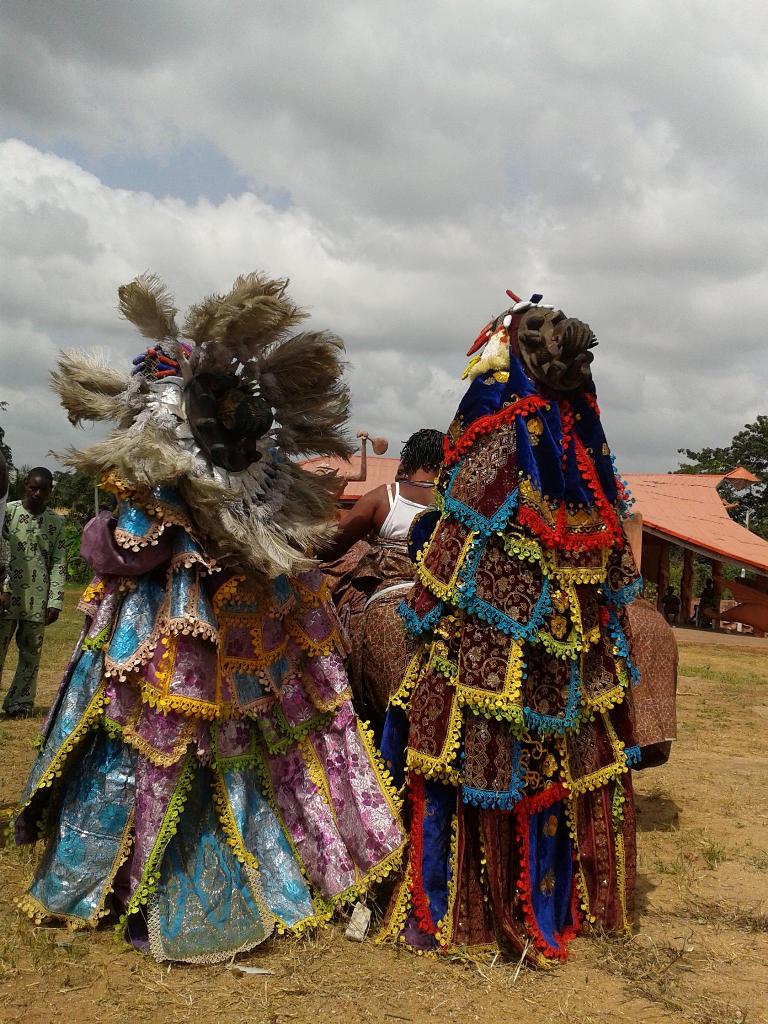 There are ways to reach a trans-state through dance and through the rhythm of drumming. This is certainly not the only way to reach a trance (there are also those who take certain psychotropic stimulants), but I will explain the dance. The experience of a trance-dance can take different measures, from relaxation and soft dancing, to the feeling that someone else controls your body. In the trance-dance you can stay fully conscious, and it is possible to completely lose control. Such a loss of control over the body may look like epilepsy, yet it is not. The descent into a trance-state can also occur suddenly and uncontrollably. Shamans train in grounding and in methods of direct traveling to other levels. If the trance happens to someone who is totally unprepared, it will surely shake his stability.
There are ways to reach a trans-state through dance and through the rhythm of drumming. This is certainly not the only way to reach a trance (there are also those who take certain psychotropic stimulants), but I will explain the dance. The experience of a trance-dance can take different measures, from relaxation and soft dancing, to the feeling that someone else controls your body. In the trance-dance you can stay fully conscious, and it is possible to completely lose control. Such a loss of control over the body may look like epilepsy, yet it is not. The descent into a trance-state can also occur suddenly and uncontrollably. Shamans train in grounding and in methods of direct traveling to other levels. If the trance happens to someone who is totally unprepared, it will surely shake his stability.
When the trance happens unexpectedly, without preparation and without introduction, the easiest way is to explain it as an epilepsy attack – but thesis is a different thing. When someone experiences an epilepsy attack, from a shamanic point of view it seems that an abstract part of us comes out of the body so that it loses control. I know too little about epilepsy to be able to comment on what it actually is, but I know that the state of trance is something else. I remember a case of a woman to whom it happened once or twice a week to fall into a state of complete absence for a few minutes. It has been found that it is not epilepsy, but a spiritual journey. Most likely, she directly and consciously entered into this state, and now spontaneously this skill manifests itself, somethinig she has carried with her not knowing that there was. This is one possible explanation. Many people who receive quick spiritual insights for which they are not prepared nor have the proper support, are going to end up in institutions, under sedatives and with diagnoses of mental imbalance or disorder.
Similar is the case with autism… Different mental states can be accompanied by an exceptional (sensory) sensitivity or susceptibility for the manifestation of the invisible.
A friend of mine has the habit of telling from time to time: – I have the symptoms of autism. Those are the periods when she is not willing to socialize, staying turned into her own world. Where is the limit? To what extent is this behavior acceptable, and when does it receive a diagnosis? In a way, we all need socialization – to be involved and alive in this world. In the ifa philosophy, autism is explained by the so-called energy of Egbe.
At the time of pregnancy, the soul anchors in this life in which it will come by birth. When they arrive into this world, children are still in close touch with the world from which they came, a fact that manifests itself with imaginary (spiritual) friends with they frequently talk and play with. Usually they tell us that this is only part of children’s exuberant imagination, but in fact it is the connection with their spiritual source. People with autism can maintain that contact forever. The others have removed it from their heads as something that does not exist (in the same way as there exists no intuition nor emotion). Ifa studies such spiritual source according to the conception of the energy of Egbe – that is the child inside of us, those are our spiritual friends in a parallel world, and at the same time it is also our ability to socialize in this visible world. Someone is so connected to the other world that is more up than down, more there than here, more inside himself than in the real world. He cannot connect with the social life here, because he is so absorbed by the life from which he originated. But this is only a theory.
Sometimes I joke by bringing this comparison: What would happen if the Dalai Lama incarnated in our community here, and, in the second year of life, he began to talk about his experiences from past lives? Imagine he were born to parents who have no ideas about reincarnation, nor are they particularly interested in the notion of the soul. How would his being feel in this world, if his parents tried to make it fit their own beliefs? Sometimes the child is wiser and more developed than the parents themselves – and in that case can his soul manifest itself? In order to survive, one sometimes has to hide his own talents. This is another fact. The spiritual source – the child in us – bears a fundamental part of our existence, the memory of our purpose and talents, and often we just renounce that part in order to survive in this world. How then do we live? Can we without ourselves be in harmony with the world? The only thing that is important in life is to live yourself.
For someone who has a child with autism, a knowledge about the energy of Egbe contributes in the understanding of the spiritual origin of this phenomenon, but only if a parent thinks in a spiritual way. Again, autism is just one of the facts of existence, nothing terrifying. In almost every human being there is the influence of this same Egbe energy – somewhere less, somewhere in a greater extent.
Do you have any idea of the reason why more and more children are born with autism?
I believe that the cause of this lies in the lack of understanding of spiritual life. Today, it is strange to think deeply about one’s own life. What is a necessary thing has become something strange. This is the result of the century-long functioning of the society as we know it today, because nature is always going in the direction of finding the balance.
The world is imperfect. But how to truly adopt this attitude with regard to the apparent imperfections that are reasonably donated to each of us?
If we look at this planet, this power of life and movement – it is perfect – but the imperfections are within it. What triggers the so-called imperfections? The search for balance. Where there is a challenge, there is also a place for development, the search for new knowledge and solutions. A hungry lion goes into action and will then show how great is his will to survive. A lion who has been fed by people since he was little has lost much of his substance. Just like swans in the park: they are capable only to wait for what someone else will give them. When we are challenged by something that is lacking – the food because we’re hungry, the emotions because we need love – whenever you want to fill a void, this forces us to action, to evolution.
In this lies the beauty of life! Often people say that they want to have all their problems solved in their lives. They want to solve challenges – which now sounds quite differently. When someone wants to get rid of challenges, in fact, he wants to solve life. Now let’s imagine that we live in this harmonious world, where a harp is continuously playing, everything is peaceful and in harmony. This harp plays for a hundred years one and same harmonious melody and there is no need to ever start anything. This state of inaction in which we are all lifeless and the same … Would not people go crazy with such horror of perfection? In order for perfection to have life in itself, it must include imperfection! This provides dynamics, sense of time, creating challenges that force us to step forward, offering us a variety of experiences.
Is it true that people on the margins – those who live on the edge, belong to poor strata, the lowest caste, who have a different sexual orientation or identity (transgender), are socially excluded and similarly – have a better predisposition or greater motivation for the spiritual work? It often turns out that the sublime is precisely what we thought was inferior, and vice versa. Nothing has to be as it seems. In what lies the meaning of such inversions?
None of this is necessary. Someone may have the mission of going through the shamanic path, but not being anything of the aforementioned. But how to awaken this knowledge – what drives us to do that? Sometimes a man really needs some urge to begin to search for his additional forces. Just that. There is no principle affirming that a shaman is exclusively someone from the margins. Being on the margins does not mean to be predestined, but neither to be denied.
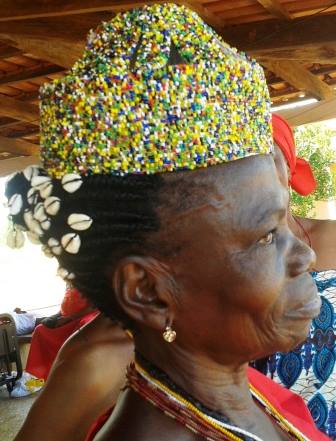 Someone has an amputated area in the emotions, someone on a mental level, someone in spirituality (which is often the case). The amplitude given to a challenge is also important. One same challenge to someone will represent the end of the world, and to somebody else nothing particular. The amplitude is individual and different. It happens that someone who has exceptional talent also gets exceptional challenges in order to develop those talents. Sometimes it is so; not always. If one is born in abundance and grew up in a way that a spoon was put in his mouth even before he felt hungry – can he know what is the value of food? Sometimes the existential edge is a motivation, but it is not a rule. If it happened that all of our water on earth was poisoned, we would learn to appreciate it. Sometimes shortages situations are a challenge. But whether someone will live the life he is destined for depends only on himself, even when the environment recognizes his talents and supports them.
Someone has an amputated area in the emotions, someone on a mental level, someone in spirituality (which is often the case). The amplitude given to a challenge is also important. One same challenge to someone will represent the end of the world, and to somebody else nothing particular. The amplitude is individual and different. It happens that someone who has exceptional talent also gets exceptional challenges in order to develop those talents. Sometimes it is so; not always. If one is born in abundance and grew up in a way that a spoon was put in his mouth even before he felt hungry – can he know what is the value of food? Sometimes the existential edge is a motivation, but it is not a rule. If it happened that all of our water on earth was poisoned, we would learn to appreciate it. Sometimes shortages situations are a challenge. But whether someone will live the life he is destined for depends only on himself, even when the environment recognizes his talents and supports them.
The feminine facing the masculine in a patriarchal code is interpreted as less worthy, less perfect, less valid; unstable under the influence of the moon, that is, the menstrual cycle, which is perceived as a weakness. How can the present-day woman reconcile herself with the processes in her own body?
We are born and live on this planet because there is the menstrual cycle, because there is the ovulation, because there is this ability to give birth and reproduce ourselves. If we deny these facts or attribute any negative sign to them, it means that we do not respect life itself – that we are in conflict with life. In traditional cultures, male and female energies have the same value, because life does not occur without one or without the other. What is the value of dreams and ideas that have not materialized? They just come and go. The materialization is the feminine energy. The female uterus is a planet Earth in miniature. This is where the soul gets its vehicle in order to be able to manifest itself in this world. In the cultures where there is a celebration of life, all this is highly respected. The process of emancipation in the Western world is essentially a competition of women in the male way, which is not yet equality. This planet of ours is exceptional, because it is influenced by both the Moon (female) and the Sun (male). Time, movement, ovulation and menstruation are influenced by the moon. The cycle of 28 days directly points to this fact. We live here and so it is. To give it a negative sign- is to curse life itself. The degradation and devaluation of the feminine does not really emphasize male power, but rather indicates a weakness. Men who had to repress something did not feel stronger, rather less valuable. Weakness is usually manifested by repressing something with a negation. Those who are really strong are aware of the power of women, and respect it. For example …: The acorn is an idea or plan (such as it is also our soul). In order for an acorn to grow into an oak tree, what does it need? Soil fertility, space, time, favorable conditions, minerals, water – if it receives all this, then it materializes. A fertile land without any plan does not give anything. A plan without a land gives the same result – nothing. What is more important then? The plan or the land? The idea or the matter? The male or the female? Both. Neither one is more nor less valuable, but it simply has different characteristics. There is no hierarchy in this. Such is the principle of shamanism. A hierarchical setting is a sign that something fell out of balance and that a part is suffering. If, therefore, we deny the feminine principle, we deny life itself. It is destructive.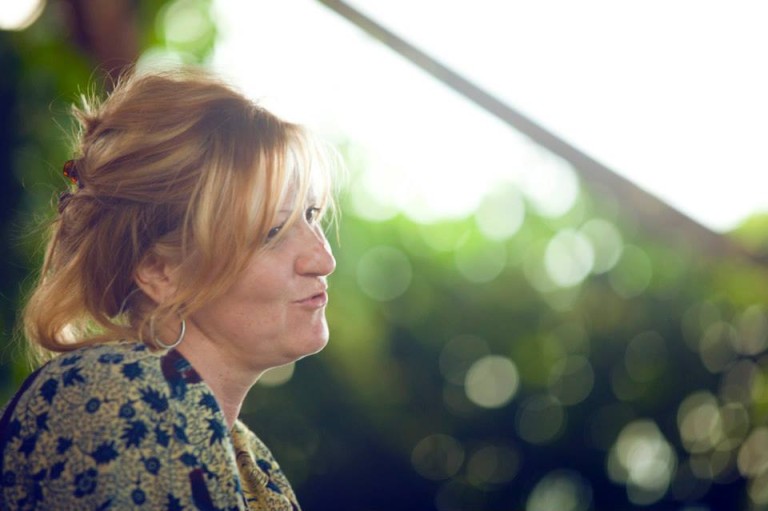
How to embrace, support and open all of our scars to the flow of power?
We should abandon the cage of our own beliefs. No fact of life is disastrous in itself, but we attribute to that such weight. Something is as it is, it is up to us to look at what we can build now with it. When we confer to something the amplitude of the problem and eternity – then it stays that way. Many, for example, have the feeling that they are not understood or accepted, and at the same time everyone crouches in his corner. They must find their flock. People are different – which is interesting. As long as we are alive, we can solve the challenges that come to us. When we give up on something as a difficult problem we actually give up on life. Instead of embarking us on a challenge from which we will develop something, we capitulate.
Anything I did not ask, but you think we should add ….?
Let me tell you a story I heard from one of my teachers from Nigeria … When he was a young student, his mother suffered a total damage of her eyesight. Medicine could not do anything. However, the mother received a number of instructions on how to continue the spiritual work on herself in accordance with her new status. Around the same time, her son went from Africa to Brazil for further education, but the situation with his mother pulled him back. She told him: – Go, be there, I will look at the world through your eyes. You are my eyes in the world. Live, and I will live through your eyes. A wise woman with extraordinary powers, she wanted her son to follow his own path. And he is really somebody who is now highly respected in his culture, who was selected to be a baba – the father of the society, its wise representative. His daughter studied medicine, and then chose the ophthalmology specialization. When she started working, she called her father to come to her office for a preventive examination. And, should I add ….? At first he refused: – What is the point of a visit if a have a good sight? But then, out of respect for her work, he went. To everyone’s surprise, it was discovered that he had the same disease from which his mother had lost her sight. If he had continued to postpone these checks, it would have been too late. Such a favorable result is certainly the fruit of what his mother had already begun – dealing with the self and the spiritual work, she redirected the path of her son.. And then when a challenge seems like a permanent and irreversible condition, we still need to work on it. Because death is not the end of life: we work for the next life, for the next generation. It is never ending. If someone finds himself in a situation of loss – of mobility, of sight – the shaman first checks to see if this can be stopped. And then the shaman helps the person to accept the new status and to develop in it. To live himself/herself. At the same time, also to prevent the repetition of her/his own forms and unconquered lessons, which supports the offspring to also live theirselves…
The interview was conducted and redacted by Marijana Čanak
